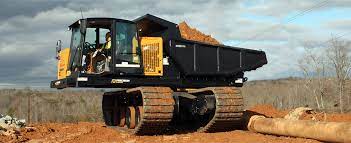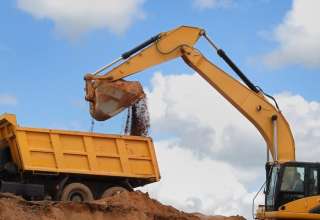
A crawler carrier is a form of construction equipment that transports huge loads or materials. They are typically employed in situations when a standard four-wheeled vehicle would be dangerous or inefficient, such as navigating rocky terrain.
To add a crawler carrier to your list of equipment, contact the heavy equipment sales experts at Worldwide Machinery. Continue reading to find out why a crawler carrier can be the perfect piece of equipment for you. The roots of this flexible technology will be revealed as well.
Crawler carriers come in various shapes and sizes, each fulfilling a distinct purpose. All of them have a low center of gravity, broad tracks, and plenty of ground clearance. They can safely and securely traverse rugged terrain and pull massive loads in due to their unique blend of features.
Benefits and Applications
Crawler carriers are frequently used to move heavy equipment. Because they can easily move huge weights, these tough devices are well-suited for use in industrial environments such as a building. They do, however, have further options. Crawler carriers can also be used for garbage collection and disaster relief.
A crawler carrier will do whatever task you designate to it. These versatile devices are built to withstand even the most challenging environments. If you want a machine that can do it all, a crawler carrier is a way to go.
Varieties of Crawler Carrier
Crawler carriers come in a range of sizes and forms, but they all have one feature: they are enormous, heavy vehicles designed to transport massive loads across rugged terrain. These workhorses can, among other things, move logs and excavate ditches.
Without a doubt, the little excavator is one of the most common types of crawler transport. This versatile tool may be used for a number of tasks, such as trenching, demolition, and excavation. You may choose the wheeled or tracked mini excavator that best meets your needs from a broad range.
If you need even more power, consider a crawler dozer. These massive machines are designed for challenging mining and construction activities. To speed up any task, a crawler dozer may be supplied with blades and rippers, among other accessories.
There is likely a crawler carrier type that will fulfill all of your requirements. Make an effort to research your possibilities so that you may choose the one that best matches your needs. Remember that size does matter when it comes to large pieces of machinery!
The Evolution of Crawler Carriers
In the 1920s, tracked loaders were built using tractor buckets. E. Boydell invented a compact loader with a tractor and a bucket in the 1930s. Modern crawler tractors are integrated systems, as opposed to previous ones, which comprised separate tractor loader shovel attachments. In the 1930s, these connections were regulated by wires and latches.
Tracked loaders have seen three design changes since then. Early prototypes were cable-powered track tractors with custom-built loaders. Loaders and dozers were crucial for hauling freight, loading railroads, and other modes of transportation despite their inability to drill into solid ground. Unworked soil may be removed more readily because of tracked loaders’ increased power and ability to reduce bucket pressure.
In 1922, the newly formed Trackson Company created one of the first crawler loader shovels. Trackson began producing tractors for Caterpillar in 1936. The next year, a cable-driven vertical lift loader attachment for Caterpillar tractors was created. The “Traxcavators” was unstable since they were mounted above the tractor hood.
Trackson employed hydraulics rather than wires to create a more portable, well-known attachment. Caterpillar dubbed their crawler loaders Traxcavator after purchasing Trackson in 1951. Rather than rely on attachments, the business developed and constructed its own loaders from the ground up. The first integrated hydraulic crawler loader is found on Caterpillar Traxcavator No. 6.
In 1946, Tractomotive in Chicago created the first hydraulic bucket. After acquiring Tractomotive, Allis-Chalmers built a slew of enormous crawler tractors. Bucyrus-Erie was also producing hydraulic attachments for International Harvester at the time. Drott aided International Harvester’s entry into the crawler loader market. Drott’s clamshell bucket changed the loader into a loader, scraper, dozer, and clamshell.
Caterpillar and Hoover Machine collaborated on the development of an overhead dozer with a front excavation. The material was then raised and dumped over the machine. The usage of overhead cab protection is required by this design. In the 1970s, hydrostatic motors were introduced to crawler tractors, allowing for joystick control of the loader and tractor. In 1971, JCB created the first rear-engine hydrostatic loader. It set the standard for future crawler loaders.
Hydraulic excavators have mostly supplanted crawler loaders. Because many of them are too large to maintain, crawler loaders are frequently utilized by organizations with particular purposes.
Bulldozers are crawlers mounted with massive metal plates (known as a blade). During construction, it is used to transport garbage, sand, and other materials. The equipment is used in manufacturing, quarrying, engineering, mining, and farming. The term “bulldozer” is commonly used to refer to the complete machine as opposed to simply the blade.
Due to their high traction tracks, dozers can readily cross difficult terrain. The weight is spread equally by the machine’s large tires, preventing it from sinking into soft ground. They’re employed in building, road construction, and terrain clearing.
According to legend, Benjamin Holt’s steam traction engine debuted in 1904 with an infinite chain tread. The Hornsby Company of England transformed a wheeled steam traction engine into a crawler. This version has a bulldozer-like look due to the propulsion of each track. Holt later bought Hornsby’s patents. To a Holt photographer shooting one of his crawler tractors, the rollers seemed to be caterpillars. The likeness impressed Holt, and he named his system after it.
- In August 1925, L. Holt’s Business and Holt’s Business Caterpillar Tractor merged to establish Holt’s Business and Holt’s Business Caterpillar Tractor. Holt’s Company and Best Gas Tractor Company C. In 1923, fashion designer J. Farmer James Cummings created the first bulldozer designs. Earl McLeod was granted a patent for a “tractor attachment” on January 6, 1925.
Automobiles with tracks, such as the Caterpillar 60, were popular in the 1920s. They can move the ground due to the powerful metal plates on their front. A U-blade, a straight blade, and a brush rake were the most often used bulldozer attachments for eliminating garbage and disseminating dirt in 1929.
Dozers have developed over time to do certain tasks. Compact equipment used in limited locations is one example of mining. To fulfill industrial demands, machines have grown larger and more sophisticated. Gradation control, hydraulic cylinders, electric motors, and automated gearboxes were all present.
Last Thoughts
The crawler carrier is an amazing piece of construction machinery. If you need help deciding whether to buy or rent, contact our specialists at Worldwide Machinery. Before making a selection, our experts can help you narrow down your options. Go to www.worldwidemachinery.com to tell us what you need.
























